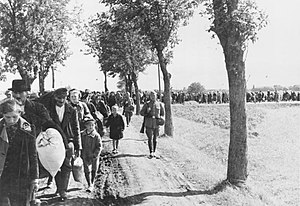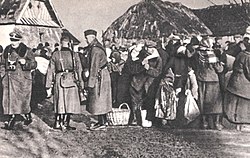
| Home | Sources Directory | News Releases | Calendar | Articles | | Contact | |
Expulsion of Poles by Germany

The partitions of Poland had ended the existence of a sovereign Polish state in the 18th century. With the rise of German nationalism in the late 19th century, Poles faced increasing discrimination. The first deportation of 30,000 Poles from the German Empire took place in 1885. While ideas of expelling Poles can be found in German political discourse of the 19th century, these ideas matured into full-scale plans during the First World War, calling for the removal of Polish population from Polish territories that were first annexed by the Russian Empire and then by Germany.[1] Before and after 1939 the Nazis exploited these ideas when creating their Lebensraum concept of territorial aggression.[1] Large scale expulsions of Poles occurred during World War II, when Nazi Germany started the Generalplan Ost campaign of ethnic cleansing in all Polish areas annexed by Nazi Germany. Although the Nazis were not able to fully implement Generalplan Ost due to the war's turn, up to 2 million Poles were affected by wartime expulsions with additional millions displaced or killed.
Contents |
[edit] Origins of the idea
Since the creation of the German Empire in 1871, Poles constituted one of its largest minorities as a result of earlier expansions of Prussia, which seized historic lands possessed by Poland, was the very state that initiated the foundation of the German Empire.[1] Prussia had seized territories with a Polish population by taking part in the Partitions of Poland and the Silesian Wars with Austria in the 18th century.
The rise of German nationalism was followed by the idea of pan-Germanism, demanding the unification of all Germans in one state, including the German diaspora. Some pan-Germanists believed that Germans were ethnically superior to other peoples ' including Slavs, whom they viewed as inferior to the German "race" and culture. The Nazi concept of Lebensraum in turn demanded "living space" for German people, claiming overpopulation of Germany and alleged negative traits of heavy urbanisation in contrast to agricultural settlement. The desired territories were to be taken in the East. Both pan-Germanism and Lebensraum theory viewed Poles as an obstacle to German hegemony and prosperity as well as future expansion of the German state.[1]
[edit] German Empire
German authorities, fearing that the possible rebirth of Poland would threaten German control over the territories annexed in her Partitions[citation needed], sought to limit the number of Poles by forced Germanisation and by new wave of settlement by German colonists.[1] Beginning with the Kulturkampf, laws were enacted to restrict Polish culture, religion, language and property. Bismarck initiated the Prussian deportations of 1885-1890, which affected some 30,000 Poles and Jews living in Germany who did not have German citizenship. This is described by E.J. Feuchtwanger as one the precedents to modern policies of ethnic cleansing.[2] In 1887 Bernhard von Bülow, the future Chancellor of the German Empire, advocated expelling Poles by force from territories which were Polish-inhabited and slated to become part of Germany.[3]
Already in 1908 Germany legalized eviction of Poles from their properties under pressure from pan-German nationalist groups who hoped this law would be used to reduce the number of Poles in the East by force.[1]
[edit] First World War
During the First World War Germany planned to annex about 30,000 km– from Congress Poland for German colonisation.[1] Most of the Polish population of those territories (about 2,000,000 people) was to be expelled into a small Polish puppet state.[1] The remaining population was to be used as agricultural labour for German colonists.[1] Germans expelled citizens of Kalisz.
[edit] Nazi Germany
With the occupation of Poland following the German invasion of the country, Nazi policies were enacted upon its Polish population on an unprecedented scale. According to Nazi ideology Poles, as Untermensch, were seen as fit only for slavery and for further elimination in order to make room for the Germans. Adolf Hitler had plans for extensive colonisation of territories in the east of the Third Reich. Poland, itself, would ' according to well documented German plans ' have been cleared of Polish people altogether, as 20 million or so would have been expelled eventually. Up to 3 or 4 million Polish citizens (all peasants) believed be descendants of German colonists and migrants and therefore considered "racially valuable" would be Germanised and dispersed among the German population.[4] Nazi leadership hoped that through expulsions to Siberia, famine, mass executions, and slave labour of any survivors Polish nation would be eventually completely destroyed.[5]
[edit] Second World War
World War II expulsions took place within two specific territories: one area annexed to Reich in 1939 and 1941, and another, the General Gouvernment, precursor to further expansion of German administrative settlement area. Eventually, as Adolf Hitler explained in March 1941, the General Gouvernment would be cleared of Poles, the region would be turned into a "purely German area" within 15'20 years and in place of 15 million Poles, 4'5 million Germans would live there, and the area would become "as German as the Rhineland.[6]
[edit] Expulsions from Polish territories annexed by Nazi Germany
Generalplan Ost (GPO) was a Nazi plan to ethnically cleanse the territories occupied by Germany in Eastern Europe during World War II. According to Czes�aw �uczak, Germans expelled the following numbers of Poles from territories annexed to the Reich in the period of 1939'1944:
| Name of territory | Number of Expulsion Poles(in thousand) |
|---|---|
| Warthegau region | 630 000 |
| Silesia | 81 000 |
| Pomerelia | 124 000 |
| Bia�ystok | 28 000 |
| Ciechanów | 25 000 |
| So called "Wild expulsions" of 1939 (Pomerelia mostly) | 30 000 ' 40 000 |
| Polish areas annexed by Nazi Germany (summary) | 918 000 ' 928 000 |
| ZamoÅ�ä� region | 100 000 ' 110 000 |
| General Government (Proving grounds) | 171 000 |
| Warsaw (after Warsaw uprising) | 500 000 |
| Summary on occupied areas | 1 689 000 ' 1 709 000 |
Combined with "wild expulsions", in four years 923,000 Poles were ethnically cleansed from territories Germany annexed into the Reich.[8]

[edit] Expulsions from General Government
On the territories of the German protoctorate called General Government there were two main areas of expulsions committed by the German state. The protectorate itself was seen as temporary measure, and served as a concentration camp for Poles to perform hard labour furthering German industry and war effort. Eventually it was to be cleared of Poles also.
[edit] ZamoÅ�ä�
116,000 Poles were expelled from the ZamoÅ�ä� region as part of Nazi plans for establishment of German colonies in the conquered territories. ZamoÅ�ä� itself was to be renamed Himmlerstadt, later changed to Pflugstadt (Plough City), that was to symbolise the German "Plow" that was to "plough" the East. Additionally almost 30,000 children were kidnapped by German authorities from their parents for potential Germanisation.[8] This led to massive resistance (see ZamoÅ�ä� Uprising).
[edit] Warsaw
In October 1940, 115 thousand Poles were expelled from their homes in central Warsaw to make room for the Jewish Ghetto, constructed there by German authorities.
After the failure of the Warsaw Uprising, 500,000 people were expelled from the city alone as punishment by German authorities.[8]
[edit] Demographic estimates
It is estimated that between 1.6 and 2 million people[9] were expelled from their homes during the German occupation of Poland. Only the German organized expulsions affected directly 1,710,000 Poles.[8] Additionally, 2.5 to 3 million Poles were taken from Poland as labourers to Germany to support the Nazi war effort.[5] These numbers do not include people arrested by the Germans and sent to Nazi concentration camps.[9]
In many instances, Poles were given between 15 minutes and 1 hour to collect their personal belongings (usually no more than 15 kilograms per person) before they were removed their homes and transported east (see: deportations) On top of that about 5 million[citation needed] Poles were sent to German concentration camps.[citation needed] A total of about 6 million Polish citizens were killed during the war.[citation needed] All these actions resulted in significant changes in Polish demographics at the end of the war.[citation needed]
[edit] See also
- Drang nach Osten (Drive towards the East)
- Expulsion of Germans after World War II
- Generalplan Ost Hitler's "new order of ethnographical relations"
- Lebensraum (Living space), one of major political ideas of Adolf Hitler
- Nazi propaganda
- Pacification operations in German-occupied Poland
- Prussian deportations of Poles and Jews in 1885-1890
- Repatriation of Poles (1944'1946)
- World War II evacuation and expulsion
[edit] Bibliography
- Maria Rutowska, "Wysiedlenia ludno�ci polskiej z Kraju Warty do Generalnego Gubernatorstwa 1939-1941" Instytut Zachodni, Poznań 2003,ISBN: 83-87688-42-8
- Czes�aw �uczak "Polityka ludno�ciowa i ekonomiczna hitlerowskich Niemiec w okupowanej Polsce", Wyd. Poznańskie, Poznań 1979 ISBN 83-210-0010-X
- Czes�aw �uczak "Po�o�enie ludno�ci polskiej w Kraju Warty 1939 - 1945", Wydawnictwo Poznańskie 1987
- CzesÅ�aw Madajczyk Generalny Plan Wschodni: Zbiór dokumentów, GÅ�ówna Komisja Badania Zbrodni Hitlerowskich w Polsce, Warszawa, 1990
- Czes�aw Madajczyk Generalna Gubernia w planach hitlerowskich. Studia, PWN, Warszawa. 1961
- Czes�aw Madajczyk Polityka III Rzeszy w okupowanej Polsce, Warszawa, 1970
- Andrzej Leszek Szcze�niak Plan Zag�ady S�owian. Generalplan Ost, Polskie Wydawnictwo Encyklopedyczne, Radom, 2001
- Piotr Szubarczyk (IPN Gdańsk), "Umacnianie niemczyzny" na polskim Pomorzu, Nasz Dziennik, 03.09.2009
- L. Chrzanowski, Wypä�dzenia z Pomorza, Biuletyn Instytutu Pamiä�ci Narodowej',2004, nr 5 (40), ss. 34 ' 48.
- W. Jastrzä�bski, Potulice. Hitlerowski obóz przesiedleÅ„czy i pracy, Bydgoszcz 1967.
[edit] References
- ^ a b c d e f g h i Imannuel Geiss, Der polnische Grenzstreifen 1914-1918. Ein Beitrag zur deutschen Kriegszielpolitik im Ersten Weltkrieg, Hamburg/Lübeck 1960
- ^ E.J. Feuchtwanger, "Bismarck", Routledge 2002
- ^ Herbert Arthur Strauss, "Hostages of Modernization: Studies on Modern Antisemitism 1870-1933-39 Germany - Great Britain-France",Walter de Gruyter 1993
- ^ Hitler's Plans.
- ^ a b Wojciech Roszkowski, Historia Polski 1914'1997, Warsaw 1998
- ^ Volker R. Berghahn "Germans and Poles 1871'1945" in "Germany and Eastern Europe: Cultural Identities and Cultural Differences",Rodopi 1999
- ^ Czes�aw �uczak, "Polityka ludno�ciowa i ekonomiczna hitlerowskich Niemiec w okupowanej Polsce" Wydawnictwo Poznańskie Poznań 1979 ISBN 832100010
- ^ a b c d Zygmunt MaÅ„kowski; Tadeusz Pieronek; Andrzej Friszke; Thomas Urban (panel discussion), "Polacy wypä�dzeni", Biuletyn IPN, nr5 (40) May 2004 / Bulletin of the Institute of National Remembrance (Biuletyn Instytutu Pamiä�ci Narodowej), issue: 05 / 2004, pages: 628, [1]
- ^ a b "Poles: Victims of the Nazi Era" at US Holocaust Memorial Museum
|
SOURCES.COM is an online portal and directory for journalists, news media, researchers and anyone seeking experts, spokespersons, and reliable information resources. Use SOURCES.COM to find experts, media contacts, news releases, background information, scientists, officials, speakers, newsmakers, spokespeople, talk show guests, story ideas, research studies, databases, universities, associations and NGOs, businesses, government spokespeople. Indexing and search applications by Ulli Diemer and Chris DeFreitas.
For information about being included in SOURCES as a expert or spokesperson see the FAQ . For partnerships, content and applications, and domain name opportunities contact us.

